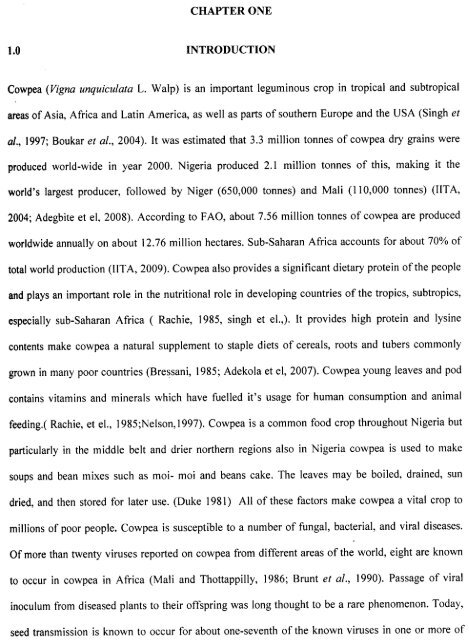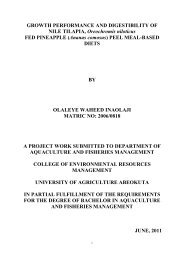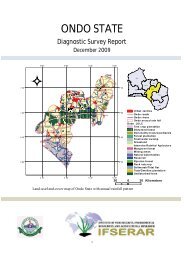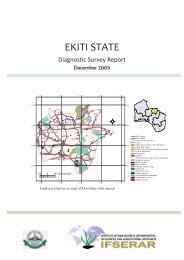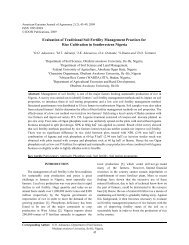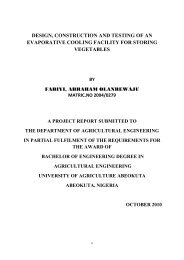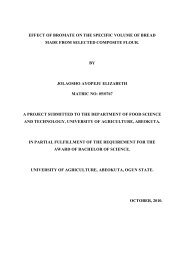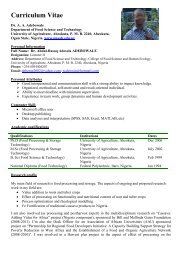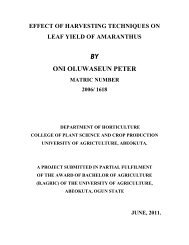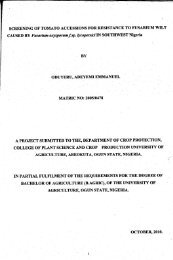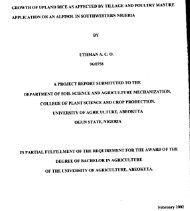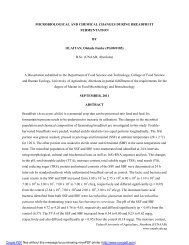TRANSMISSION OF COWPEA APHID BORNE MOSAIC VIRUS ...
TRANSMISSION OF COWPEA APHID BORNE MOSAIC VIRUS ...
TRANSMISSION OF COWPEA APHID BORNE MOSAIC VIRUS ...
Create successful ePaper yourself
Turn your PDF publications into a flip-book with our unique Google optimized e-Paper software.
Cowpea (Vigna unquiculata L. Walp) is an important leguminous crop in tropical and subtropical<br />
areas of Asia, Africa and Latin America, as well as parts of southern Europe and the USA (Singh et<br />
al., 1997; Boukar et al., 2004). It was estimated that 3.3 million tonnes of cowpea dry grains were<br />
produced world-wide in year 2000. Nigeria produced 2.1 million tonnes of this, making it the<br />
world's largest producer, followed by Niger (650,000 tonnes) and Mali (110,000 tonnes) (IITA,<br />
2004; Adegbite et el, 2008). According to FAO, about 7.56 million tonnes of cowpea are produced<br />
worldwide annually on about 12.76 million hectares. Sub-Saharan Africa accounts for about 70% of<br />
total world production (lIT A, 2009). Cowpea also provides a significant dietary protein of the people<br />
and plays an important role in the nutritional role in developing countries of the tropics, subtropics,<br />
especially sub-Saharan Africa ( Rachie, 1985, singh et el.,). It provides high protein and lysine<br />
contents make cowpea a natural supplement to staple diets of cereals, roots and tubers commonly<br />
grown in many poor countries (Bressani, 1985; Adekola et el, 2007). Cowpea young leaves and pod<br />
contains vitamins and minerals which have fuelled it's usage for human consumption and animal<br />
feeding.( Rachie, et el., 1985;Nelson,1997). Cowpea is a common food crop throughout Nigeria but<br />
particularly in the middle belt and drier northern regions also in Nigeria cowpea is used to make<br />
soups and bean mixes such as moi- moi and beans cake. The leaves may be boiled, drained, sun<br />
dried, and then stored for later use. (Duke 1981) All of these factors make cowpea a vital crop to<br />
millions of poor people. Cowpea is susceptible to a number of fungal, bacterial, and viral diseases.<br />
Of more than twenty viruses reported on cowpea from different areas of the world, eight are known<br />
to occur in cowpea in Africa (Mali and Thottappilly, 1986; Brunt et al., 1990). Passage of viral<br />
inoculum from diseased plants to their offspring was long thought to be a rare phenomenon. Today,<br />
seed transmission is known to occur for about one-seventh of the known viruses in one or more of


